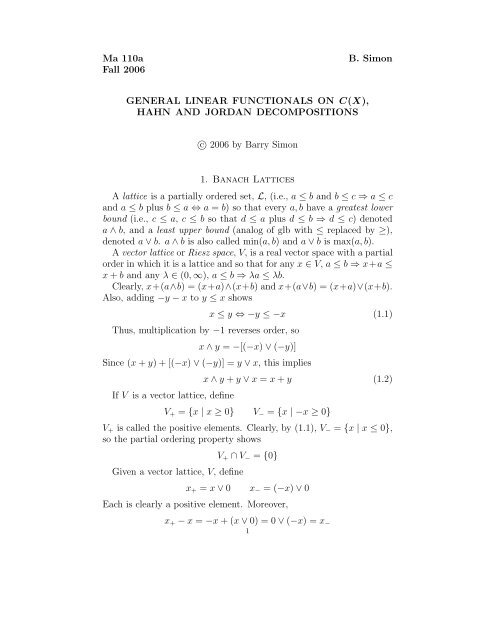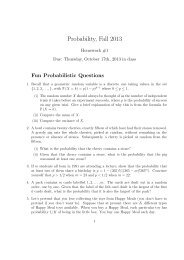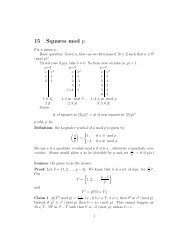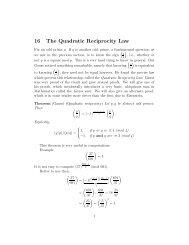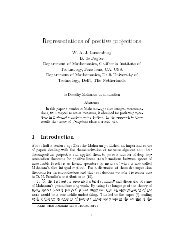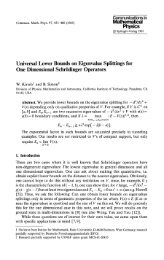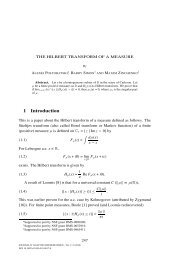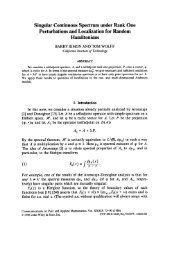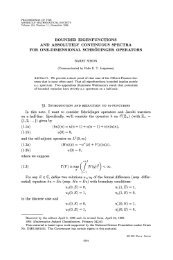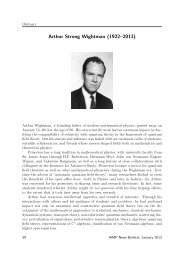Banach Lattices and the Dual of C(X)
Banach Lattices and the Dual of C(X)
Banach Lattices and the Dual of C(X)
Create successful ePaper yourself
Turn your PDF publications into a flip-book with our unique Google optimized e-Paper software.
Ma 110a B. Simon<br />
Fall 2006<br />
GENERAL LINEAR FUNCTIONALS ON C(X),<br />
HAHN AND JORDAN DECOMPOSITIONS<br />
c○ 2006 by Barry Simon<br />
1. <strong>Banach</strong> <strong>Lattices</strong><br />
A lattice is a partially ordered set, L, (i.e., a ≤ b <strong>and</strong> b ≤ c ⇒ a ≤ c<br />
<strong>and</strong> a ≤ b plus b ≤ a ⇔ a = b) so that every a, b have a greatest lower<br />
bound (i.e., c ≤ a, c ≤ b so that d ≤ a plus d ≤ b ⇒ d ≤ c) denoted<br />
a ∧ b, <strong>and</strong> a least upper bound (analog <strong>of</strong> glb with ≤ replaced by ≥),<br />
denoted a ∨ b. a ∧ b is also called min(a, b) <strong>and</strong> a ∨ b is max(a, b).<br />
A vector lattice or Riesz space, V, is a real vector space with a partial<br />
order in which it is a lattice <strong>and</strong> so that for any x ∈ V, a ≤ b ⇒ x+a ≤<br />
x + b <strong>and</strong> any λ ∈ (0, ∞), a ≤ b ⇒ λa ≤ λb.<br />
Clearly, x+(a∧b) = (x+a)∧(x+b) <strong>and</strong> x+(a∨b) = (x+a)∨(x+b).<br />
Also, adding −y − x to y ≤ x shows<br />
Thus, multiplication by −1 reverses order, so<br />
x ≤ y ⇔ −y ≤ −x (1.1)<br />
x ∧ y = −[(−x) ∨ (−y)]<br />
Since (x + y) + [(−x) ∨ (−y)] = y ∨ x, this implies<br />
If V is a vector lattice, define<br />
x ∧ y + y ∨ x = x + y (1.2)<br />
V+ = {x | x ≥ 0} V− = {x | −x ≥ 0}<br />
V+ is called <strong>the</strong> positive elements. Clearly, by (1.1), V− = {x | x ≤ 0},<br />
so <strong>the</strong> partial ordering property shows<br />
Given a vector lattice, V, define<br />
V+ ∩ V− = {0}<br />
x+ = x ∨ 0 x− = (−x) ∨ 0<br />
Each is clearly a positive element. Moreover,<br />
x+ − x = −x + (x ∨ 0) = 0 ∨ (−x) = x−<br />
1
2 NOTES FOR MA 110A<br />
so x = x+ − x−. We define |x| by<br />
|x| = x+ + x− x = x+ − x− (1.3)<br />
A <strong>Banach</strong> lattice is a vector lattice, X, which is a <strong>Banach</strong> space <strong>and</strong><br />
which obeys<br />
|x| ≤ |y| ⇒ x ≤ y (1.4)<br />
for any x ∈ X. Notice since | |x| | = |x|, (1.4) implies<br />
|x| = x (1.5)<br />
Examples. If X is a compact Hausdorff space, C(X) is a <strong>Banach</strong><br />
lattice with pointwise order (i.e., f ≤ g ⇔ f(x) ≤ g(x) for all x) <strong>and</strong><br />
· ∞. Similarly, L p (X, dµ) is a <strong>Banach</strong> lattice.<br />
We need <strong>the</strong> following:<br />
Lemma. Let V be a vector lattice.<br />
(i) If x = a+ − a− with a± ≥ 0, <strong>the</strong>n x± ≤ a±.<br />
(ii) |x| = x+ ∨ x−.<br />
Pro<strong>of</strong>. (i) Since x + a− = a+, we have a+ ≥ x, <strong>and</strong> clearly, a+ ≥ 0, so<br />
a+ ≥ x ∨ 0 = x+. Similarly, a− ≥ (−x) ∨ 0 = x−.<br />
(ii) By (1.2), this is equivalent to x+ ∧x− = 0. Since 0 ≤ x+, 0 ≤ x−,<br />
y = x+ ∧ x− ≥ 0. We have x = (x+ − y) − (x− − y) is a difference <strong>of</strong><br />
positive elements since x± − y ≥ 0, so by (i), y ≤ 0. Thus, y = 0. <br />
Proposition. We have that in any vector lattice,<br />
−g ≤ f ≤ g ⇒ |f| ≤ g (1.6)<br />
Pro<strong>of</strong>. First, −g ≤ g ⇒ 2g ≥ 0 ⇒ g ≥ 0. Next, f ≤ g <strong>and</strong> g ≥ 0<br />
implies f+ ≤ g. Similarly, f− ≤ g. By <strong>the</strong> lemma,<br />
|f| = f+ ∨ f− ≤ g<br />
2. Decomposition <strong>of</strong> BLFs on <strong>Banach</strong> <strong>Lattices</strong><br />
The main result here is<br />
Theorem. Let X be a <strong>Banach</strong> lattice. Any bounded linear function<br />
ℓ: X → R can be written<br />
ℓ = ℓ+ − ℓ−<br />
<br />
(2.1)<br />
where ℓ± ≥ 0 (i.e., f ≥ 0 ⇒ ℓ±(f) ≥ 0). Moreover, <strong>the</strong> decomposition<br />
can be done so that<br />
(i) If ℓ = k+ − k− with k± ≥ 0, <strong>the</strong>n ℓ± ≤ k±.
(ii) For any f ≥ 0, we have<br />
NOTES FOR MA 110A 3<br />
ℓ+(f) + ℓ−(f) ≤ ℓ f (2.2)<br />
Remark. It is an interesting exercise to show this implies X ∗ with<br />
<strong>the</strong> order ℓ ≥ k if <strong>and</strong> only if ℓ(f) ≥ k(f) for f ≥ 0 is a lattice <strong>and</strong><br />
ℓ± = 0 ∨ (±ℓ).<br />
The interest for us will be what it says about C(X) ∗ .<br />
Lemma. In a vector lattice, if 0 ≤ f ≤ g + h with g ≥ 0, h ≥ 0, <strong>the</strong>n<br />
we can find g1, h1 so 0 ≤ g1 ≤ g, 0 ≤ h1 ≤ h, <strong>and</strong> f = g1 + h1.<br />
Pro<strong>of</strong>. Let g1 = f ∧ g so 0 ≤ g1 ≤ g. Define h1 = f − g1 ≥ 0 since<br />
g1 ≤ f. Moreover,<br />
g1 + h = (f + h) ∧ (g + h) ≥ f<br />
since f + h ≥ f <strong>and</strong> g + h ≥ f. Thus, h1 = f − g1 ≤ h. <br />
Pro<strong>of</strong> <strong>of</strong> Theorem. Define for f ≥ 0,<br />
ℓ+(f) ≡ sup(ℓ(g) | 0 ≤ g ≤ f)<br />
Clearly (taking g = 0), ℓ+(f) ≥ 0 <strong>and</strong><br />
so ℓ+(f) < ∞ <strong>and</strong><br />
for<br />
We claim for g, h ≥ 0,<br />
|ℓ(g)| ≤ ℓ g ≤ ℓ f<br />
ℓ+(f) ≤ ℓ f<br />
ℓ+(g + h) = sup(ℓ(f) | 0 ≤ f ≤ g + h)<br />
ℓ+(g + h) = ℓ+(g) + ℓ+(h) (2.3)<br />
= sup(ℓ(g1 + h1) | 0 ≤ g1 ≤ g, 0 ≤ h1 ≤ h) (by <strong>the</strong> lemma)<br />
= ℓ+(g) + ℓ+(h)<br />
Moreover, if λ > 0 is real, ℓ+(λf) = λℓ+(f).<br />
Now define for any f,<br />
ℓ+(f) = ℓ+(f+) − ℓ+(f−)<br />
Then, if<br />
f = q+ − q−<br />
with q+, q− ≥ 0, q+ + f− = q− + f+, so by (2.3),<br />
In particular, since<br />
ℓ+(f) = ℓ+(q+) − ℓ+(q−)<br />
g + h = (g+ + h+) − (g− + h−)
4 NOTES FOR MA 110A<br />
we find that<br />
For λ > 0 <strong>and</strong> real,<br />
<strong>and</strong><br />
ℓ+(g + h) = ℓ+(g+ + h+) − ℓ+(g− + h−)<br />
= ℓ+(g+) + ℓ+(h+) − ℓ−(g−) − ℓ+(h−)<br />
= ℓ+(g) + ℓ+(h)<br />
ℓ+(λf) = ℓ+(λf+) − ℓ+(λf−) = λℓ+(f)<br />
ℓ+(−f) = ℓ+(f−) − ℓ+(f+)<br />
= −ℓ+(f)<br />
Therefore, ℓ+ is a linear functional.<br />
Clearly,<br />
so<br />
<strong>and</strong> ℓ = ℓ+ − ℓ−.<br />
Note that<br />
ℓ+(f) ≥ ℓ(f)<br />
ℓ− ≡ ℓ+ − ℓ ≥ 0<br />
ℓ−(f) = sup(ℓ(g − f) | 0 ≤ g ≤ f)<br />
= sup(−ℓ(h) | 0 ≤ h ≤ f) (2.4)<br />
by taking h = f − g.<br />
Suppose ℓ = k+−k−. Then 0 ≤ g ≤ f implies ℓ(g) = k+(g)−k−(g) ≤<br />
k+(g) ≤ k+(f), so taking sups, ℓ+ ≤ k+. Using (2.4), we get ℓ− ≤ k−.<br />
Finally, given f ≥ 0 <strong>and</strong> g, h so 0 ≤ g ≤ f, 0 ≤ h ≤ f, we have<br />
−f ≤ g − h ≤ f, so |g − h| ≤ f <strong>and</strong> so by <strong>the</strong> <strong>Banach</strong> lattice property<br />
g − h ≤ f. Thus,<br />
|ℓ(g) − ℓ(h)| = |ℓ(g − h)|<br />
≤ ℓ g − h<br />
≤ ℓ f<br />
Taking <strong>the</strong> sup <strong>of</strong> ℓ(g) over all g <strong>and</strong> −ℓ(h) over all h, we find that<br />
(2.2) holds. <br />
Corollary. If ℓ ∈ C(X) ∗ , <strong>the</strong>n ℓ = ℓ+ − ℓ− with ℓ± ≥ 0 <strong>and</strong><br />
ℓ+ + ℓ = ℓ (2.5)
NOTES FOR MA 110A 5<br />
Pro<strong>of</strong>. We only need to check (2.5). But ℓ± = ℓ±(1), so<br />
ℓ+ + ℓ− = ℓ+(1) + ℓ−(1) ≤ ℓ<br />
by (2.2) with f = 1. Since ℓ = ℓ+ − ℓ−,<br />
ℓ ≤ ℓ+ + ℓ−<br />
proving (2.5). <br />
A signed Baire measure on X is an assignment <strong>of</strong> a real number,<br />
µ(A), to each Baire set so that <strong>the</strong>re is C < ∞ obeying if X = A1 ∪<br />
· · · ∪ An <strong>and</strong> Ai ∩ Aj = ∅, <strong>the</strong>n<br />
n<br />
|µ(Aj)| ≤ C (2.6)<br />
j=1<br />
<strong>and</strong> for any countable family <strong>of</strong> disjoint sets {Aj} n j=1 , we have µ(∪Aj) =<br />
µ(Aj) (<strong>the</strong> sum converges absolutely by (2.6)). Given such a measure,<br />
as usual we can form a Stieltjes-type functional ℓ on C(X) with<br />
|ℓ(f)| ≤ f∞ so ℓ = ℓ+ − ℓ− <strong>and</strong> µ = µ+ − µ−. We set |µ| = µ+ + µ−.<br />
Conversely, any µ+ − µ− defines a signed measure. We thus have <strong>the</strong><br />
Riesz–Markov <strong>the</strong>orem for signed measures which says <strong>the</strong>re is a oneone<br />
correspondence between signed measures <strong>and</strong> elements <strong>of</strong> C(X) ∗ .<br />
3. Hahn <strong>and</strong> Jordan Decompositions<br />
As we have seen, every signed measure µ induces an ℓ which can<br />
be written as µ+ − µ− where µ± obeys µ+ + µ− = µ <strong>and</strong> if<br />
µ = ν+ − ν− with ν± ≥ 0, <strong>the</strong>n µ± ≤ ν±. Here we will prove two<br />
famous <strong>the</strong>orems:<br />
Hahn Decomposition Theorem. There exists a Baire set, A, so<br />
that for all C,<br />
µ+(C) = µ(A ∩ C) (3.1)<br />
µ−(C) = −µ((X \ A) ∩ C) (3.2)<br />
µ = µ(A) + µ(X \ A) (3.3)<br />
Jordan Decomposition Theorem. µ+ <strong>and</strong> µ− are mutually singular.<br />
Recall |µ| is <strong>the</strong> positive measure µ+ + µ−. We will deduce <strong>the</strong> two<br />
<strong>the</strong>orems above from<br />
Theorem. There exists a Baire function, g, with |g(x)| = 1 for d|µ|<br />
a.e. x so that <br />
f dµ = fg d|µ| (3.4)
6 NOTES FOR MA 110A<br />
for all f ∈ C(X).<br />
Pro<strong>of</strong>. First, without loss <strong>of</strong> generality, we can suppose µ = 1. We<br />
start by noting µ(f+) = µ+(f+) − µ−(f+) ≤ µ+(f+) <strong>and</strong> µ(f+) ≥<br />
−µ−(f+) so |µ(f+)| ≤ |µ|(f+). Similarly, |µ(f−)| ≤ |µ|(f−), so<br />
<br />
|µ(f)| ≤ |f| d|µ| (3.5)<br />
As in von Neumann’s pro<strong>of</strong> <strong>of</strong> <strong>the</strong> RN <strong>the</strong>orem, we have<br />
<br />
|µ(f)| ≤ |f| 2 1/2 d|µ|<br />
since d|µ| = µ = 1, so <strong>the</strong>re is g ∈ L2 with<br />
<br />
µ(f) = g(x)f(x) d|µ|(x) (3.6)<br />
Originally, this is true for f ∈ C(X), but by use <strong>of</strong> <strong>the</strong> dominated<br />
convergence <strong>the</strong>orem, we can define µ(f) for f any bounded Baire<br />
function <strong>and</strong> both (3.6) <strong>and</strong> (3.5) hold.<br />
Now let ε > 0 <strong>and</strong> let f be <strong>the</strong> characteristic function <strong>of</strong> {x | g(x) ><br />
1 + ε} ≡ Aε. Then (3.6) says<br />
<strong>and</strong> (3.5) says<br />
µ(f) ≥ (1 + ε)|µ|(Aε)<br />
|µ(f)| ≤ |µ|(Aε)<br />
It follows that |µ|(Aε) = 0. Taking ε = 1/2 n , we see g(x) ≤ 1 for a.e.<br />
x. Similarly, g(x) ≥ −1, so<br />
so<br />
|g(x)| ≤ 1 a.e. x (3.7)<br />
From (3.6), we have for f ∈ C(X),<br />
<br />
|µ(f)| ≤ |g| d|µ| f∞<br />
(3.8)<br />
<br />
1 = µ ≤ |g| d|µ| (3.9)<br />
Since |µ(X)| = 1 <strong>and</strong> (3.7) holds, we see |g(x)| = 1 for a.e. x. <br />
Pro<strong>of</strong> <strong>of</strong> <strong>the</strong> Hahn Decomposition Theorem. Define<br />
so<br />
A = {x | g(x) = +1}<br />
X \ A = {x | g(x) = −1}
For f ∈ C(X), let<br />
<br />
ν+(f) =<br />
NOTES FOR MA 110A 7<br />
<br />
fχA d|µ| ν−(f) =<br />
fχX\A d|µ|<br />
so ν± ≥ 0 <strong>and</strong> ν+ − ν− = µ. Thus ν± ≥ µ±. But ν+(1) + ν−(1) =<br />
|µ|(X) = 1 = µ+(1) + µ−(1) implies ν+ − µ+ = µ− − ν− = 0. Thus<br />
µ+ is <strong>the</strong> measure associated to χAd|µ|, that is, µ+(B) = |µ|(B ∩ A) =<br />
µ(B ∩ A) since µ−(B ∩ A) = |µ|((X \ A) ∩ (B ∩ A)) = 0.<br />
Pro<strong>of</strong> <strong>of</strong> <strong>the</strong> Jordan Decomposition Theorem. By <strong>the</strong> Hahn <strong>the</strong>orem,<br />
µ+ <strong>and</strong> µ− are mutually singular.<br />
By combining this analysis with <strong>the</strong> von Neumann pro<strong>of</strong>, one gets<br />
Theorem. Let dµ be a signed Baire measure <strong>and</strong> dν a positive Baire<br />
measure. Then<br />
dµ = dµac + dµsing<br />
where<br />
dµac = f(x) dν(x)<br />
for f ∈ L 1 (R, dν) <strong>and</strong> dµsing is singular with respect to dν in <strong>the</strong> sense<br />
that <strong>the</strong>re is A with ν(X \ A) = 0 <strong>and</strong> µ(B) = 0 for all B ≤ A<br />
(equivalently, |µ|(A) = 0).<br />
Pro<strong>of</strong>. We have d|µ| = h dν + d|µ|sing, so dµ = g dν + g d|µ|sing.


